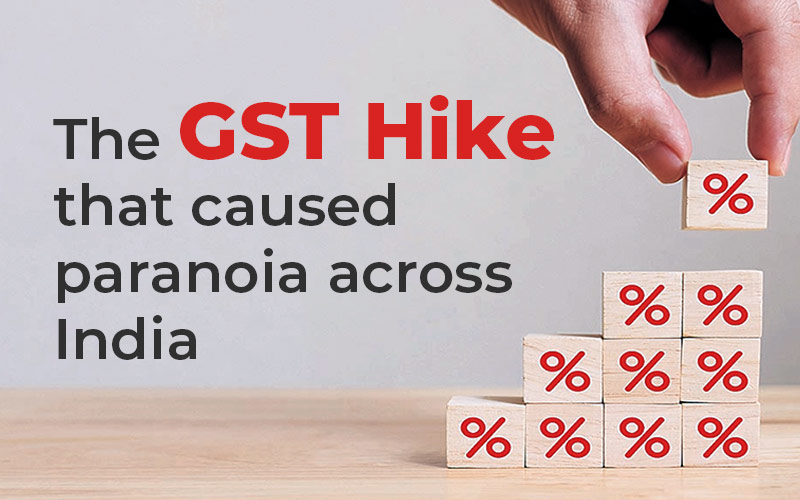
The GST Hike that caused paranoia across India
It’s been more than a couple of days since the 47th GST Council Meet was chaired by Union Minister Finance Nirmala Sitharamanji and quite a few announcements were made related to revisions in the GST implications. One of the changes that caused much uproar among the public and other stakeholders was the newly implied GST of 5% on pre-packaged and labelled food items in the non-branded category, which was earlier exempted from the purview of GST. Whereas other commodities such as ink, pencil sharpeners, knives, spoons, LED lamps, solar water heaters, power-driven pumps, etc. were moved to the 18% GST bracket from the 12% GST bracket. Other commodities/services that saw a hike in GST levied were hotel rooms under Rs. 1000 / night, hospital beds over Rs. 5,000, and so on. On the contrary, services such as ropeways, logistics, implants and intraocular lenses saw a reduction in GST rates.
According to Sitharaman, these revisions were taken unanimously during the two-day council meet held in Chandigarh. This suggests that the council had gone through all potential changes that could impact the market and the end user. Soon enough, several criticisms were raised after the announcement was made - the outrage was particularly towards raising GST on essential items, and there were also concerns among small businesses about suffering loss due to increased costs induced by the GST hike.
However, in a series of tweets, Sitharaman clarified the reasons behind the revisions made.
She also drew attention to the fact that this was not the first time taxes were imposed on food items, and states like Punjab and UP collected Rs. 2000 Cr and Rs. 700 Cr on food grains via purchase taxes in the pre-GST regime.
It is in this context that the GST Council in its 47th meeting took the decision. With effect from July 18, 2022, only the modalities of imposition of GST on these goods was changed with no change in coverage of GST except 2-3 items. (7/14)
— Nirmala Sitharaman (@nsitharaman) July 19, 2022
A recap of the GST launch in 2017
The introduction of GST in India happened five years ago in 2017 with the motive of eliminating multiple tax structures operating within the nation and replacing it with a unified tax structure under the notion of - ‘One nation, one market, one tax’. However, rolling out a unified tax structure in a dynamic and diverse market like India is no easy feat. Especially, when it was to be implemented in the midst of a rocky economic scenario. Although the long-term benefit of GST implementation in the nation is anticipated to promote economic growth, its short-term impact was likely to put the market under stress, as a result of which the end user would have to bear the brunt of higher costs.
That being said, the initial GST regime had exempted essential food commodities such as unbranded packaged food items from its purview. In addition, to further offer relief to state governments, the central Govt. at the time had allowed compensation for a period of five years on any loss of revenue incurred due to the implementation of the GST.
However, as already noted, the 47th GST Council Meet announced the 5% GST imposition on pre-packaged and labelled food items in the non-branded category. Also, the compensation tenure of the state governments has come to an end. To this, the state govt has sought an extension on the compensation tenure to recover from the loss incurred during the pandemic. The 48th GST Council is expected to straighten out its stand on the matter while announcing a couple of other changes to the GST implications.
Why are GST revisions being introduced?
There’s no one factor that aptly sums up the rationale behind the GST hike. But it may be stated that these decisions are taken with a viewpoint of regulating the long-term growth of our economy, at the expense of short-term market fluctuations (and frustrations) as are being noted at the moment.
It is also important to note that, as per a study taken up by RBI, the average tax rate levied by the Govt. fell to 11.4% at the launch of GST back in 2017. Whereas the ideal tax rate should be not less than 15.6% since it adversely affects the nation’s economy. The changes that we’re seeing in the GST imposition are intended to put the average tax rate at par with the norm so as to not sustain future revenue losses. Further, to augment revenue, certain changes in the GST tax rate for various categories of commodities are being done to correct the inverted duty structure.
It is true that these changes will increase the burden faced by the common man. However, there are larger problems to be solved by the Govt., without which we as a nation stand to lose big, especially in the face of global economic uncertainty.
From the common man's perspective, our everyday purchases have gotten costlier. However, the increase in prices due to the added 5% GST on pre-packaged and labelled commodities, as per market experts, is actually insignificant.
The clarifications provided by Sitharamanji also throw light on how certain businesses were misusing the provisions of GST exemptions previously given to packaged commodities that were in the non-branded category for tax evasion and were resented by suppliers and industry associations who had been paying taxes on branded goods. This resulted in a decline in revenue collection across states.
Despite the hue and cry expressed over the price and GST hikes, there’s one key takeaway that we must all understand - any subsequent decrease in GST rate (as desired by the market) will not necessarily contribute to the required economic growth of our nation; in the same way that the marginal increase in prices due to GST hikes will not necessarily lead India’s economy to a downfall.
It’s safe to conclude that the economic circumstances at the moment are quite fragile, not only in India but all across the globe. At such a time, there is immense pressure on the Govt. to tread carefully so as to avoid any unwanted economic crisis. It may help to keep a positive mindset and put our focus on augmenting individual wealth in the best possible measures at one’s disposal.
Disclaimer: The opinions expressed in this article are those of the author's. They do not purport to reflect the opinions or views of The Critical Script or its editor.

Newsletter!!!
Subscribe to our weekly Newsletter and stay tuned.
















Related Comments